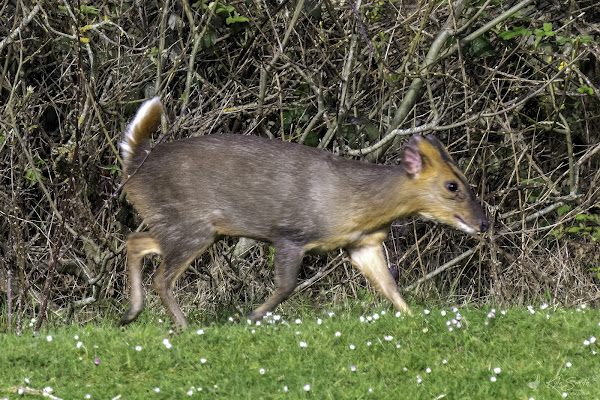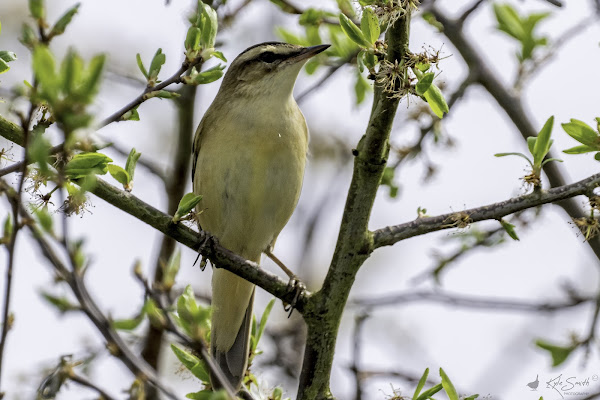I left work just after 6.00pm and when having dinner, noticed an update on the Banbury Birders WhatsApp that two Arctic terns had been found at Grimsbury Resevoir by John Friendship-Taylor @987jonty. There was a follow-up message from Kev Heath @kev07713 to say they were still present and that there were also yellow and white wagtails. My wife said she was going to pop to the shops and so I decided to nip back to the other end of town and see if I could tick these long-distance migrants.
Arctic terns undertake one of the longest migrations of any bird species, traveling from their breeding grounds in the Arctic to their wintering grounds in the Antarctic, and back again; they cover an astonishing distance of up to 44,300 miles round trip, equivalent to traveling more than twice around the circumference of the Earth. They typically arrive or passing through the UK in late April to early May, and breed in colonies located in the Arctic and sub-Arctic regions, including the British Isles, nesting on coastal cliffs, rocky islands, and sometimes even on floating icebergs.
I arrived to find Mark Ribbons, and Kev & Karen Heath watching the birds feed across the water, unusually not diving for fish but seemingly catching flies over the water. As the light fell, and we sheltered from occasional rain showers, the terns gracefully worked up and down the water, never diving in. Kev picked out the yellow wagtail through his scope on the far bank (also a year tick for me) but couldn't relocate the white wagtail. A good couple of mid-weeks ticks - I usually don't bird in the week.
Saturday arrived, and we agreed to drop down into Berkshire for nightingale and Dartford Warbler - nothing like the sound of nightingales in the Spring. They typically arrive in the UK in April, marking the onset of spring, their arrival coinciding with the availability of suitable breeding habitat and the emergence of insects. Nightingales undertake an arduous migration journey of thousands of miles, crossing the Mediterranean Sea and Sahara Desert - the exact route and distance covered varies between individuals and populations, but they typically travel several thousand miles. Once they have established territories, Nightingales begin to sing to attract mates and defend their nesting sites. Their beautiful and melodious song is a hallmark of spring in the UK, filling the air with rich, flute-like notes during the dawn and dusk hours.
Arriving onto site we set off across the gorse-rich and bush/tree lined perimeter immediately seeing a chiffchaff coming off the ground and a very vocal common whitethroat in the hedges, giving me a run-around to get a photo; this is my first of the year.
We walked on, watching for Dartford's but seeing plenty of stonechats when Kev stopped and pointed to where he'd heard the start of a nightingale call - then it went into full song, and we moved along the path to see if we could get a view. For a good 15 minutes we couldn't see it but could easily narrow it down to an area; we simply enjoyed the song. Eventually we caught some movement and could see the bird but when it stopped again it was still deep in the bush and I couldn't get a clear line for a photo - we'd have had to walk across to the bush and that wouldn't have been acceptable, especially as it was on territory. A year tick in any case. Behind and through the trees I could see a male bullfinch - that has taken a while to tick this year!
We saw and heard a woodlark high in the sky but out of reach and when it dropped it was far over and in the region of tall dense trees. We picked out a Dartford warbler in a low tree just as it dropped down and out of view, into a patch of low gorse. Within a couple of minutes, it popped up and shot left into a further line of gorse. Yet another year tick.
We circled back at the end of the path and found lots of dog walkers with their beasts off lead - while most were not distracted we saw one chasing a pair of muntjac deers, completely out of control - really there should be signs, especially at this time of year where there will be a lot of ground nesting birds - and to protect against dogs with insufficient training. While being flushed left and right by walkers (mostly with dogs), a wheatear fed along a stretch of grass close to us. So far this year I've been unable to get close enough to one for a photo - here was my chance. Beyond me a handful of linnets and meadow pipits fed on the ground and I picked out a whinchat but it was flushed before Kev could get on it.
We followed a path running parallel to the one we'd come out on, and heard another nightingale behind, deciding not to search for it. A Dartford perched in a tree ahead but against the bright sky and so it was a job to pick out the features. Another stonechat, this one a female perched low on some gorse to the left and four/five house martins dropped on a large puddle ahead before leaving as quickly as they arrived.
While we heard more woodlarks, today was not our day for a close encounter and so after reaching the end of the circuit we stopped for a coffee before making our way back to RSPB Otmoor to see if we could pick up any warblers recently returned.
There was a lot of water in the car park at Otmoor which rendered a number of the spaces relatively unusable/undesirable. We waited for a chap and his sone to pack up and depart to take their spot. We turned the first corner and came across a vocal and showy chiffchaff, dancing around the base of a hedgerow - it exhibited a strong supercilium which caught our attention, although it already had to be honest, especially the way it flapped its wings as we watched.
Our key now was to follow the bridleway and see some sedge warblers, which we did very quickly, however getting one out in the open for a photo was somewhat of a challenge. The birds were in general out of sight - a couple from Somerset stopped for a chat and remarked how subdued it was now, compared to when they arrived at late breakfast time. There were quite a few marsh harriers over Greenaways and some interactions with the red kites, but it was all rather quiet. There were brimstone and peacock butterflies and our first dragonfly of the Spring, but nothing really to excite.
We then managed to get a sedge warbler that didn't mind being seen and I got my photo. Another first of the year but we couldn't locate a reed bunting or any other migrants just in.
It had been a good day out with some cracking migrants just in, so we pulled stumps, and I dropped Kev back home. I'm away on business for the next week and so it will likely be a couple of weeks before I get out again.
Year list: 180.


















No comments:
Post a Comment